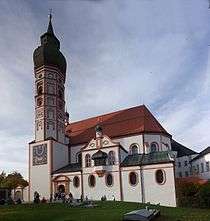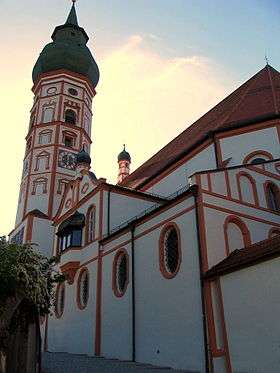Andechs Abbey
The Benedictine priory and erstwhile abbey of Andechs is a place of pilgrimage on a hill east of the Ammersee in the Landkreis of Starnberg (Upper Bavaria) in Germany, in the municipality Andechs. Andechs Abbey is famed for its flamboyant Baroque church and its brewery, Klosterbrauerei Andechs. Composer Carl Orff is buried in the church.

Counts and dukes of Andechs
The site of Andechs was originally occupied by a castle belonging to the counts of Dießen on the Ammersee, probably built on a Roman castrum, and remained the seat of the powerful counts of Dießen-Andechs (1135 to 1180) and dukes of Andechs-Merania (1180 to 1248). In 1132 the count donated his ancestral seat at Dießen to the Holy See and moved to Andechs.

Otto II of Andechs was bishop of Bamberg from 1177 – 1196. In 1208, when Philip of Swabia, King of the Germans, was assassinated at Bamberg by Otto of Wittelsbach, members of the house of Andechs were implicated, and the castle at Andechs was razed before the family was rehabilitated.
Saint Hedwig of Andechs (ca 1174 – October 1243) born at Andechs, was one of eight children born to Berthold IV, Count of Dießen-Andechs and Duke of Istria. Of her four brothers, two became bishops, Ekbert of Bamberg (1203 – 1231), and Berthold, Patriarch of Aquileia; Otto succeeded his father as Duke of Dalmatia, and Heinrich became Margrave of Istria. Of her three sisters, Gertrude of Andechs-Merania (1185–September 24, 1213) was the first wife of Andrew II of Hungary and the mother of St Elisabeth of Hungary; Mechtilde became Abbess of Kitzingen; while Agnes, a famous beauty, was made the unlawful wife of Philip Augustus of France in 1196, on the repudiation of his lawful wife, Ingeborg of Denmark, but was dismissed in 1200, after Pope Innocent III laid France under an interdict.
When the dukes' direct male line of Andechs-Merania was extinguished in 1248, the entire region was annexed by the bishop of Bamberg. A history of the house of Andechs was written by Joseph Hormayr, Baron zu Hortenburg, the historian-statesman, and published in 1796.
The heilige Berg

In 955, relics brought from Rome and the Holy Land by Rasso, count of Diessen, to his monastery at Wörth (later called Grafrath) were transferred to the heilege Berg (holy mountain) to preserve them from the ravages of the Hungarians. In the 12th century three hosts, reputed to have been consecrated by Pope Gregory I and Pope Leo IX, were added to the relics at the heilige Berg. The first documented pilgrimages to Andechs were in 1138, when count Berthold II ordered his subjects to make the journey to venerate the relics in the chapel of St Nicholas at the Schloss. The legendary rediscovery of long-lost reliquaries in 1388 revived the ancient pilgrimage trade. The Andechs hosts were approved by Cardinal Nicholas of Cusa, otherwise a foe of such cults of wonder hosts.[1]
The late-Gothic collegiate church which Duke Ernest I (1392 – 1438) had erected in 1423 was changed into a Benedictine monastery by Duke Albert III in 1455, and filled with monks from Tegernsee Abbey. In 1458 it was raised to the status of an abbey, and thenceforth enjoyed a period of uninterrupted prosperity, completely remodeled in Baroque style in 1712, and forming part of the Hofmark Erling (Heiliger Berg Andechs) until its secularization in 1803. It was refounded in 1850 as a Benedictine priory, affiliated to the Abbey of St Boniface in Munich. The present church dates from the 18th century. The 20th-century German composer Carl Orff is buried there. There are also the graves of 11 members of the House of Wittelsbach inside the church, mostly from the 15th and 16th centuries. More recent burials of members of the former Bavarian Royal Family took place on a graveyard in the abbey garden, installed by Albrecht, Duke of Bavaria in 1977, due to the fact that the royal tomb at Theatine Church, Munich had no more space.
Erling, huddled at the foot of the abbey, was created as an independent town in 1818. Erling, Frieding and Machtlfing were united in 1978 as the Gemeinde Andechs.
Burials
.jpg)
- Carl Orff, 20th-century German composer
- Prince Konrad of Bavaria
- Albrecht, Duke of Bavaria
- Prince Konstantin of Bavaria
- Prince Heinrich of Bavaria (1922–1958)
See also
References
- Mitchell B. Merback, Pilgrimage and Pogrom: Violence, Memory and Visual Culture at the Host Miracle Shrines of Germany and Austria, Chicago: University of Chicago Press, 2012, 163-170.
External links
| Wikimedia Commons has media related to Kloster Andechs. |
Further reading
Birgitta Klemenz, Kloster Andechs, Regensburg: Schnell & Steiner, 2005. ISBN 3-7954-1670-1, ISBN 978-3-7954-1670-6